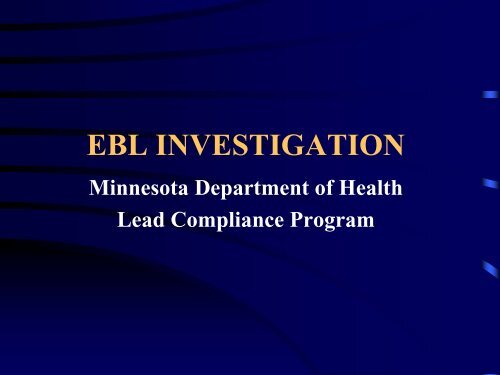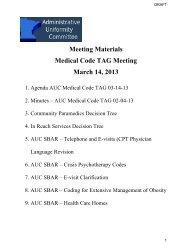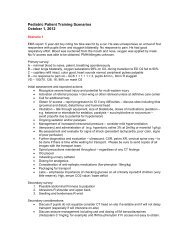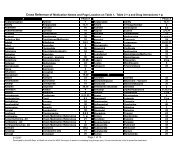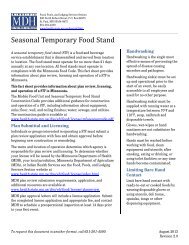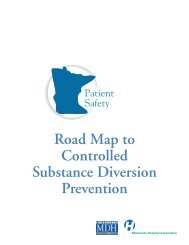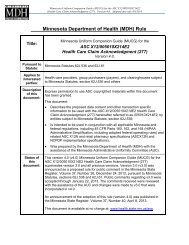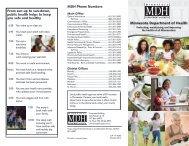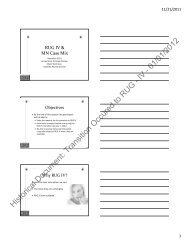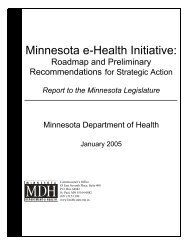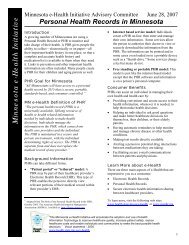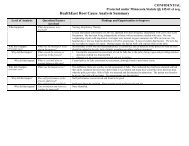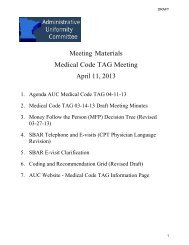EBL INVESTIGATION - Minnesota Department of Health
EBL INVESTIGATION - Minnesota Department of Health
EBL INVESTIGATION - Minnesota Department of Health
You also want an ePaper? Increase the reach of your titles
YUMPU automatically turns print PDFs into web optimized ePapers that Google loves.
<strong>EBL</strong> <strong>INVESTIGATION</strong><br />
<strong>Minnesota</strong> <strong>Department</strong> <strong>of</strong> <strong>Health</strong><br />
Lead Compliance Program
What is an <strong>EBL</strong> Investigation?<br />
• Identify a cause or causes for the lead<br />
poisoning <strong>of</strong> a child<br />
– A comprehensive investigation <strong>of</strong> all sources <strong>of</strong> lead<br />
in a child’s environment<br />
• A risk assessment attempts to identify<br />
lead-based paint hazards in a dwelling
Response to <strong>EBL</strong> Cases<br />
• Educational Intervention at 10 µg/dL or greater<br />
• Environmental Follow-up at 20 µg/dL or greater; or<br />
at 15 µg/dL to 19.9 µg/dL persistent for 90 days:<br />
– Receive report <strong>of</strong> <strong>EBL</strong> from database<br />
– Contact public health agency (e.g., PHN)<br />
– Risk assessment<br />
– Lead hazard reduction (e.g., Abatement)<br />
– Clearance testing<br />
– Case closure (Environmental)
Primary Prevention<br />
• Risk assessment at level above 10 µg/dl (venous)<br />
• Persistent or increasing level, multiple children<br />
with elevated blood leads, etc.,<br />
• Recommendations only
Assessing Agencies<br />
• MDH (82 Counties)<br />
• City <strong>of</strong> Minneapolis<br />
• City <strong>of</strong> Richfield<br />
• City <strong>of</strong> Bloomington<br />
• St. Paul/Ramsey County<br />
• Hennepin County<br />
• Dakota County<br />
• St. Louis County<br />
• Stearns County
• Paint:<br />
Lead Standards<br />
– 0.5% or more by dry weight or 5,000 ppm<br />
– 1.0 milligram per square centimeter<br />
• Dust:<br />
– Floor/carpeting - 40 µg/ft² (hazard and clearance)<br />
– Window sill - 250 µg/ft² (hazard and clearance)<br />
– Window well - 400 µg/ft² (hazard and clearance)<br />
• Bare soil: 100 ppm (hazard and clearance<br />
• Water: 15 ppb (µg/liter)
Methods for detecting Lead in Paint<br />
• X-ray fluorescence analyzer (XRF)<br />
• Paint chip analysis<br />
• Dust wipe analysis<br />
• Qualitative chemical test kits
How Widespread is Lead Paint<br />
in Housing?<br />
• Before 1940 → 87 percent<br />
• 1940 - 1959 → 69 percent<br />
• 1960 - 1978 → 24 percent<br />
• All housing → 40 percent
LBP in Residential Housing<br />
• Over 60 million homes<br />
built before 1978 contain<br />
lead-based paint<br />
• Some homes are more<br />
prone to LBP hazards<br />
– Older, pre-1960 units<br />
– Poor condition<br />
– Unsafe renovation or lack<br />
<strong>of</strong> maintenance<br />
– Exterior contaminated<br />
soil<br />
10
Preliminary Activities<br />
• Establish contact with home owner<br />
• Background information (e.g., renovation)<br />
• Contact with public health nurse<br />
– Translation issues<br />
– Case history <strong>of</strong> child/family<br />
• Other residential dwellings
Site Activities<br />
• Detailed questionnaire or interview:<br />
– In single-family, owner-occupied dwellings, the<br />
information includes resident use patterns, such as<br />
where the child’s principal play area is located, and<br />
information regarding the physical characteristics <strong>of</strong><br />
the property<br />
– In rental dwellings (multi-family), this information<br />
provides details about management and maintenance<br />
practices and occupancy status <strong>of</strong> the buildings
Site Activities<br />
• Visual inspection or walkthrough:<br />
– Serves to identify the existence <strong>of</strong> deteriorated paint,<br />
assess the extent and causes <strong>of</strong> the deterioration, and<br />
evaluate other potential lead hazards, including bare soil<br />
areas<br />
– The risk assessor uses this information to make decisions<br />
with respect to sample locations inside and outside the<br />
affected property
Site Activities
Site Activities
Site Activities
Site Activities
Site Activities
Site Activities<br />
• Paint Inspection<br />
– Deteriorated surfaces (e.g. windows)<br />
– Friction, impact, and chewable<br />
surfaces<br />
• Dust samples<br />
– Play areas<br />
– Child’s bedroom<br />
• Bare soil samples<br />
– Sandbox or playground area
Site Activities<br />
• Water Samples<br />
– required if no other sources found<br />
– domestic and bottled water supply<br />
• Other painted surfaces<br />
– Deteriorated furniture<br />
– Chewed surfaces<br />
• Dust on work clothing, food shelving,<br />
car interiors, toys, et cetera
Site Activities<br />
• Vinyl mini-blinds<br />
• Folk remedies/foods<br />
• Pewter and antique items<br />
• Glazed dinnerware or ceramics<br />
• Batteries (e.g. automotive)<br />
• Ammunitions<br />
• Hobbies (e.g. stained glass)<br />
• Lead sinkers
Site Activities
Site Activities
Site Activities
Site Activities
Site Activities
What if there is no lead?<br />
• Review <strong>of</strong> affected property<br />
– Additional sampling to verify previous results<br />
– Closer examination <strong>of</strong> surrounding areas<br />
• Child occupancy patterns<br />
– Where does child like to hide?<br />
– Behaviors not previously disclosed<br />
– Other dwelling units not addressed<br />
• Folk remedies<br />
– Hard to find with certain cultures
• Abatement<br />
Terminology<br />
– Measures designed with intent to permanently<br />
eliminate LBP or LBP hazards<br />
– May include removal, replacement, permanent<br />
enclosure, and encapsulation<br />
– Includes cleaning and clearance<br />
• Interim Controls<br />
– Measures to temporarily reduce human<br />
exposure to lead-based paint hazards<br />
– May include repairs, painting, cleaning, ongoing<br />
LBP maintenance, and management programs
Lead Safe Work Practices<br />
• Wet methods<br />
• HEPA Vacuum<br />
• Worksite preparation<br />
• Cleanup <strong>of</strong> debris<br />
• Disposal issues<br />
• Paint stabilization
Prohibited Methods<br />
• Open flame burning<br />
• Using heat guns over 700 o F<br />
• Dry sanding or dry scraping<br />
• Using certain paint strippers<br />
in poorly ventilated space<br />
• Machine sanding or grinding<br />
Abrasive blasting or sandblasting<br />
without HEPA local exhaust control<br />
30
Lead Orders<br />
• Identification <strong>of</strong> lead hazards<br />
– Risk assessment report<br />
• Lead hazard reduction options<br />
– Abatement<br />
– Interim Controls<br />
• Hiring a certified firm to do work<br />
• Resources for homeowners<br />
– Clear Corp<br />
– Grants (DTED, MHFA)<br />
– HEPA vacuum rental
Enforcement<br />
• <strong>Minnesota</strong> Statute, section 144.0904, subd. (5)<br />
– Requires that orders be completed by owner<br />
– Failure to comply results in penalties up to $10,000<br />
– Forgivable and Non-forgivable APO
Clearance Testing<br />
• Visual determination<br />
– Exterior and interior areas<br />
• Follow-up dust sampling<br />
– Locations previously sampled<br />
– Windows & floors (4 rooms)<br />
– Entrance or pathway to work area<br />
• Clearance test results<br />
– Re-occupancy issues
Case Closure<br />
• Lead hazard reduction is complete<br />
– Visual inspection <strong>of</strong> property<br />
• Clearance results are below standards<br />
• Compliance letter sent to owner<br />
– Environmental case is closed<br />
– Medical follow-up continues
MDH Staff – Risk Assessors<br />
• St. Paul Office - (651) 215-0890<br />
Contact: Dan Locher, Bruce Lange<br />
• Fergus Falls Office - (218) 739-7585<br />
Contact: Greg Boole<br />
• Rochester Office - (507) 292-5196<br />
Contact: Robert Miles


